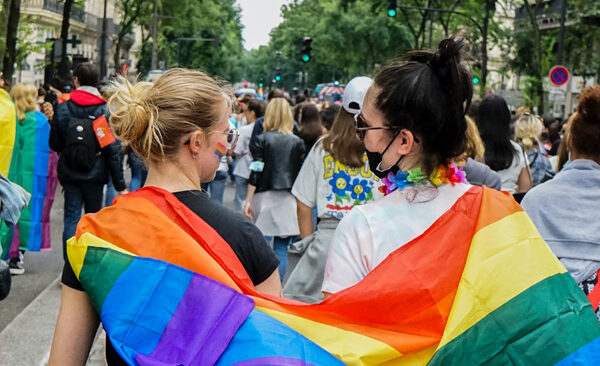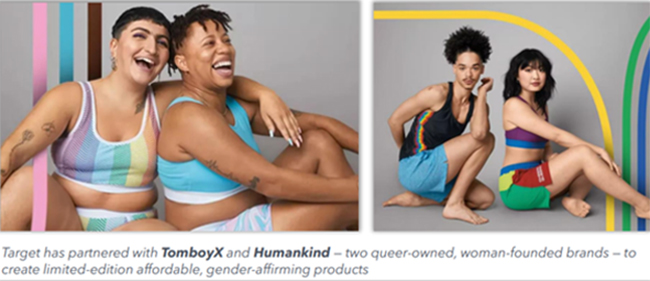Target Boycott: LGBTQ+ Inclusivity vs. Brand Loyalty

Navigating the complex landscape of LGBTQ+ inclusivity and brand loyalty.
Today’s consumers are more vocal than ever, holding brands accountable when they perceive actions—whether embracing progressive values or scaling back Diversity, Equity, and Inclusion (DEI) initiatives—as misaligned with stated commitments. Target has found itself at the center of this growing tension. In June 2023, the retailer faced significant backlash for its Pride Month collection, with some consumers accusing the brand of being “too woke,” leading to boycotts and a decline in revenue. Fast forward to 2025, and Target is again facing controversy, this time for pulling back on its DEI efforts. New data from Collage reveals that Target’s brand sentiment has turned negative (LINK TO RESEARCH SUMMARY), highlighting the challenges of navigating today’s rapidly shifting consumer landscape. For brands, effectively managing these moments is critical—not just to mitigate risk but to build resilience, maintain trust, and foster lasting brand loyalty.
Here is the article we wrote in May 2023 with helpful suggestions on addressing backlash.
Target Boycott: What Is Going On With Target?
The Target boycott began in May 2023. That is, Target became embroiled in a significant controversy as consumers chose to sever their commercial and social connections with the retailer in protest.
What were consumers protesting?
The catalyst for this boycott was Target’s presentation of products related to Pride Month, an annual celebration honoring the LGBTQ+ community. This boycott movement was primarily spearheaded by a small-but-vocal contingent of conservative influencers, often using misinformation, but the knock-on effects endangered Target’s long-standing relationship with the LGBTQ+ community, plus liberal segments.
In response to the escalating pressures exerted through social media, boycott movements, and threats of violence, Target opted to downplay their Pride Month campaigns and in some cases remove or relocate its Pride merchandise from highly visible front displays to less conspicuous areas within their stores.
However, this seemingly innocuous adjustment had unintended consequences. It created the perception that Target was opportunistic, insincere, and lacking in conviction. Consequently, the brand found itself subject to criticism from both sides of the debate.
How Much Has Target Lost as a Result of This Backlash?
During the second quarter of 2023, Target’s in-store sales dropped by 5.4%, with a more substantial decline of 10.9% for online sales. This downturn is likely a direct consequence of the boycott against Target.
The Story That Uncovers Distinctive Insights Around the Target Controversy
In 2022 Target Was a Top Brand for the LGBTQ+ Community
Research conducted by Collage Group has identified Target as an exceptionally resonant brand within the LGBTQ+ community, a distinction highlighted in our 2022 report, “The Top 10 Brands for LGBTQ+ Consumers.”
Our research shows that Target’s support for LGBTQ+ merchants, creators, and community organizations has had a positive effect on how such consumers view the brand. As a result, in 2022, this positioning enhanced favorability and purchase intent with the LGBTQ+ demographic.
- Brand Favorability: An impressive 69% of the LGBTQ+ community reports that they ‘like’ or ‘love’ the Target brand, surpassing Collage Group’s average of 50% for the LGBTQ+ segment.
- Purchase Intent: A substantial 69% of the LGBTQ+ community indicates that they are ‘likely’ or ‘very likely’ to purchase Target’s products or services in the future, compared to the average of 46% for the LGBTQ+ segment.
What Steps Has Target Taken to Garner Support From the LGBTQ+ Community?
Target consistently demonstrates its commitment to the LGBTQ+ consumer group by actively showcasing its support during Pride Month. For example, every June, Target prominently features a range of Pride-themed merchandise, including rainbow t-shirts, and greeting cards.
However, Target’s dedication extends well beyond these annual symbolic gestures. The retailer takes meaningful steps by offering affordable options for gender-affirming clothing all year round. The brand creates a safe and inclusive space for individuals to express their authentic selves. This aligns Target’s brand fit closely with the LGBTQ+ community and fosters a strong level of connection.
Moreover, Target has formed partnerships with TomboyX and Humankind, both queer-owned and woman-founded brands, to launch limited-edition lines of affordable, gender-affirming clothing.

Additionally, Target actively supports organizations and initiatives that provide life-saving services to LGBTQ+ youth, both online and in schools. Given that 60% of LGBTQ+ Americans express concerns about the proliferation of anti-LGBTQ+ ideas on social media (compared to 39% of non-LGBTQ+ individuals), Target’s efforts to combat this issue are particularly impactful. For instance, the retailer’s ongoing support for GLSEN aligns with its mission to establish welcoming, accessible, and anti-racist environments for LGBTQ+ students.
These findings underscore Target’s commendable efforts to create a welcoming and supportive environment for this consumer group, ultimately creating a strong consumer-brand bond.
Considering this context, what led to Target angering consumers within the LGBTQ+ community?
Understand the Factors Behind the Target Backlash
At Collage Group, we’ve developed a product that measures advertising effectiveness. An important metric for these measurements is ‘backlash.’ In essence, backlash measures the change in how consumers perceive a brand after watching an advertisement. That is, does the consumer’s perception of a brand shift from a positive to a negative view when they are exposed to an ad?
Where can we send you the full article?
This post includes a small sample of the deep cultural intelligence that fuels growth for our members. Contact us to unlock more content like this.
The backlash Target has faced from both sides of the cultural spectrum underscores a fundamental challenge for brands: defining their values and aligning their strategies with the consumers most critical to their growth. Whether facing boycotts for being “too woke” in 2023 or scrutiny for scaling back DEI efforts in 2025, the consequences of misalignment are swift and significant, impacting both brand momentum and purchase intent. More importantly, inclusive marketing remains an essential tool for engaging diverse audiences, demonstrating authenticity, and fostering cultural fluency. Building a sustainable brand requires an ongoing commitment to deeply understanding cultural values, consumer expectations, and shifting dynamics. As brands navigate this evolving landscape, prioritizing authenticity and strategic inclusivity will be key to maintaining trust, relevance, and long-term success.